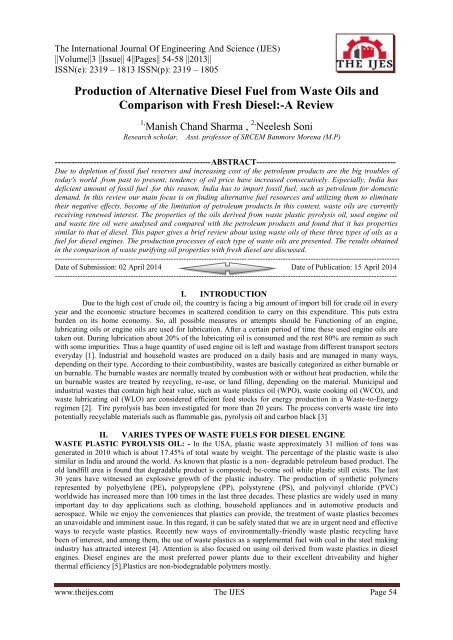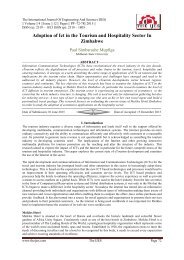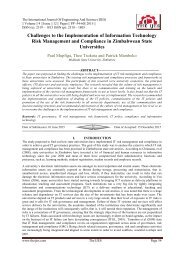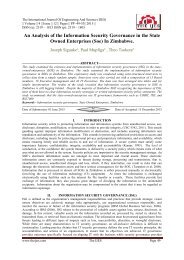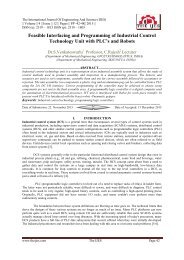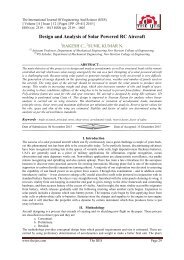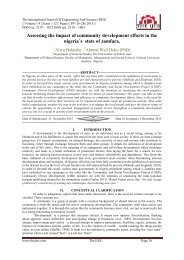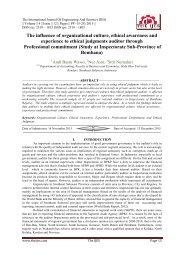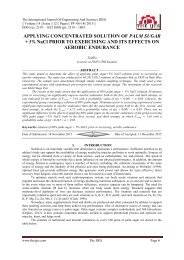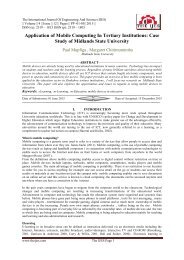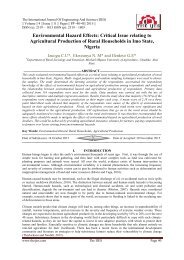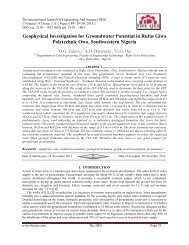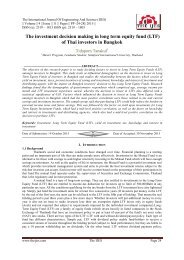p18n9tjim71m151a5sjrv1jkbb9mb.pdf
You also want an ePaper? Increase the reach of your titles
YUMPU automatically turns print PDFs into web optimized ePapers that Google loves.
The International Journal Of Engineering And Science (IJES)<br />
||Volume||3 ||Issue|| 4||Pages|| 54-58 ||2013||<br />
ISSN(e): 2319 – 1813 ISSN(p): 2319 – 1805<br />
Production of Alternative Diesel Fuel from Waste Oils and<br />
Comparison with Fresh Diesel:-A Review<br />
1, Manish Chand Sharma , 2, Neelesh Soni<br />
Research scholar,<br />
Asst. professor of SRCEM Banmore Morena (M.P)<br />
--------------------------------------------------------ABSTRACT--------------------------------------------------<br />
Due to depletion of fossil fuel reserves and increasing cost of the petroleum products are the big troubles of<br />
today's world .from past to present, tendency of oil price have increased consecutively. Especially, India has<br />
deficient amount of fossil fuel .for this reason, India has to import fossil fuel, such as petroleum for domestic<br />
demand. In this review our main focus is on finding alternative fuel resources and utilizing them to eliminate<br />
their negative effects, become of the limitation of petroleum products.In this context, waste oils are currently<br />
receiving renewed interest. The properties of the oils derived from waste plastic pyrolysis oil, used engine oil<br />
and waste tire oil were analysed and compared with the petroleum products and found that it has properties<br />
similar to that of diesel. This paper gives a brief review about using waste oils of these three types of oils as a<br />
fuel for diesel engines. The production processes of each type of waste oils are presented. The results obtained<br />
in the comparison of waste purifying oil properties with fresh diesel are discussed.<br />
----------------------------------------------------------------------------------------------------------------------------------------<br />
Date of Submission: 02 April 2014 Date of Publication: 15 April 2014<br />
---------------------------------------------------------------------------------------------------------------------------------------<br />
I. INTRODUCTION<br />
Due to the high cost of crude oil, the country is facing a big amount of import bill for crude oil in every<br />
year and the economic structure becomes in scattered condition to carry on this expenditure. This puts extra<br />
burden on its home economy. So, all possible measures or attempts should be Functioning of an engine,<br />
lubricating oils or engine oils are used for lubrication. After a certain period of time these used engine oils are<br />
taken out. During lubrication about 20% of the lubricating oil is consumed and the rest 80% are remain as such<br />
with some impurities. Thus a huge quantity of used engine oil is left and wastage from different transport sectors<br />
everyday [1]. Industrial and household wastes are produced on a daily basis and are managed in many ways,<br />
depending on their type. According to their combustibility, wastes are basically categorized as either burnable or<br />
un burnable. The burnable wastes are normally treated by combustion with or without heat production, while the<br />
un burnable wastes are treated by recycling, re-use, or land filling, depending on the material. Municipal and<br />
industrial wastes that contain high heat value, such as waste plastics oil (WPO), waste cooking oil (WCO), and<br />
waste lubricating oil (WLO) are considered efficient feed stocks for energy production in a Waste-to-Energy<br />
regimen [2]. Tire pyrolysis has been investigated for more than 20 years. The process converts waste tire into<br />
potentially recyclable materials such as flammable gas, pyrolysis oil and carbon black [3]<br />
II. VARIES TYPES OF WASTE FUELS FOR DIESEL ENGINE<br />
WASTE PLASTIC PYROLYSIS OIL: - In the USA, plastic waste approximately 31 million of tons was<br />
generated in 2010 which is about 17.45% of total waste by weight. The percentage of the plastic waste is also<br />
similar in India and around the world. As known that plastic is a non- degradable petroleum based product. The<br />
old landfill area is found that degradable product is composted; be-come soil while plastic still exists. The last<br />
30 years have witnessed an explosive growth of the plastic industry. The production of synthetic polymers<br />
represented by polyethylene (PE), polypropylene (PP), polystyrene (PS), and polyvinyl chloride (PVC)<br />
worldwide has increased more than 100 times in the last three decades. These plastics are widely used in many<br />
important day to day applications such as clothing, household appliances and in automotive products and<br />
aerospace. While we enjoy the conveniences that plastics can provide, the treatment of waste plastics becomes<br />
an unavoidable and imminent issue. In this regard, it can be safely stated that we are in urgent need and effective<br />
ways to recycle waste plastics. Recently new ways of environmentally-friendly waste plastic recycling have<br />
been of interest, and among them, the use of waste plastics as a supplemental fuel with coal in the steel making<br />
industry has attracted interest [4]. Attention is also focused on using oil derived from waste plastics in diesel<br />
engines. Diesel engines are the most preferred power plants due to their excellent driveability and higher<br />
thermal efficiency [5].Plastics are non-biodegradable polymers mostly.<br />
www.theijes.com The IJES Page 54
Production Of Alternative Diesel Fuel From Waste....<br />
The extent of conversion of plastics or plastic derived waxes into light engine fuels can be increased by<br />
the application of stable hydro cracking catalysts. Similar to petroleum derived cracking products, the fractions<br />
from plastics processing contain appreciable quantities of aromatics and unsaturated hydrocarbons [6]. Some of<br />
the properties and characteristics of waste plastic oil and diesel are compared .Because of the olefin content, it<br />
would be reasonable to submit the derived fractions to the hydrogenation step, typical of pyrolysis or cracking<br />
gasoline hydro refining process. Similarly, because of large quantity of linear n paraffinic Hydrocarbons it<br />
would be profitable to isomerise them in order to lower cloud and freezing points. The results showed that waste<br />
plastic disposal oil when mixed with heavy oils reduces the viscosity significantly and improves the engine<br />
performance [7]. However, very little work has been done to test their use in high-speed diesel engines. Flow<br />
chart of the production of diesel from waste plastic in figure -1[8]<br />
FIGURE-1<br />
III. RESULTS OF PRODUCED DIESEL FROM WASTE PLASTIC PYROLYSIS OIL:-<br />
Production of diesel from waste plastic pyrolysis oil are found from pyrolysis process which is shown in above<br />
figure -1 produced diesel properties compare with fresh diesel properties which is shown in table-1 [8],<br />
RESULTS PRODUCTION OF DIESEL FROM PLASTIC PYROLYSIS OIL COMPARISON WITH<br />
FRESH DIESELIN TABLE-1<br />
PROPERTIES<br />
DIESEL<br />
PLASTIC<br />
PYROLYSIS<br />
OIL<br />
Heating value 45814.74 46199.12<br />
C% 87 83.79<br />
H% 13 11.36<br />
O% 2<br />
Cl% na 0.03<br />
S% …… ………<br />
Density @30o<br />
(g/cc) 0.7994 0.8147<br />
Viscosity @<br />
40o (cp) 1-4.11 2.49<br />
Flash point 70 100<br />
TABLE-1<br />
This is completely shown that the produced diesel from waste plastic oil is more suitable for diesel engine<br />
which is considered through the comparison with fresh diesel and less pollutant for environment.<br />
www.theijes.com The IJES Page 55
Production Of Alternative Diesel Fuel From Waste....<br />
IV. USED ENGINE OIL<br />
Waste lubricant oils and bio fuels are two important alternative fuel sources proved to be the best<br />
substitutes for existing petro fuels, since waste generated oils represent more than 60% of used lubricant oils.<br />
Therefore, waste oils are one of the most abundant pollutant residues that are generated nowadays, reaching the<br />
value of 24 million metric tonnes per year [9]. In recent years, recycling of the waste lubricant oils and utilizing<br />
of the products as fuels have become important topics for researchers. Most of the lubricant oils are generally<br />
obtained from petroleum resources. Petroleum-derived base oils currently account for about 97% of the total<br />
lubricant production [10]. However, these oils become waste oils harmful for environment after a certain time<br />
period. Recycling of the waste lubricant oils by purifying and converting them into fuels is very important in<br />
terms of protection of the environment. After waste lubricant oils are converted into fuels, they can be used as<br />
fuels in internal combustion engines. In recycling process, waste lubricant oils are exposed to various processes,<br />
and then used as fuel or they are converted into various chemicals in order to minimize the harmful effects of<br />
these wastes [10]. Millions of tons of used oils are disposed through dumping on the ground or in water, land<br />
filling, or non-energy- recovery [10]. The used or waste oils can be refined and treated to produce fuels or<br />
lubricating oil base stock. On the other hand, the waste oils pose an environmental hazard due to both their<br />
metal content and other contaminants [11]. The high-volume waste oils can be turned into valuable fuel products<br />
by refining and treating processes. Converting of the waste oils into diesel and gasoline-like fuels to be used in<br />
engines without disposing is very important. Utilization of the diesel and gasoline-like fuels produced from the<br />
waste lubricant oils, and blending of the produced fuels with gasoline or turpentine decrease consumption of<br />
petroleum based fuels, protecting environment from toxic and hazardous chemicals [10]. It also saves of foreign<br />
exchange, reduces greenhouse gas emissions and enhances regional development especially in developing<br />
countries [12].Used engine oil are easily found from bus & trucks garages and provide diesel fuel from the<br />
purifying process such as acid treatment ,neutralization ,clay treatment and blending which are shown in<br />
figure -2 [1]<br />
RESULTS OF PRODUCED DIESEL FROM USED ENGINE OIL: Production of diesel from used engine<br />
oil with the help of purifying process such as acid treatment , neutralization , clay treatment , blinding &<br />
filtering with WOTEC machine which is shown in Figure-2 [1].Clay-treated used engine oil could be used<br />
directly as a diesel fuel considered through comparison with fresh diesel properties which is shown in table-2.<br />
RESULTS PRODUCTION OF DIESEL FROM USED ENGINE OIL COMPARISON WITH FRESH<br />
DIESEL IN TABLE-2[1]<br />
PROPERTY<br />
DIESEL<br />
DIESEL<br />
FROM<br />
UEO<br />
HCV kj/kg 42592.2 42930.79<br />
API gravity 34.05 30.06<br />
Aniline point 51.6 61<br />
Diesel index 43 43<br />
Viscosity 1.98 5.05<br />
Flash point 60 73<br />
Fire point 68 77<br />
Cloud point -15 -8<br />
Pour point -18 -16<br />
pb ( ppm) 0.1723 0.2053<br />
TABLE-2<br />
www.theijes.com The IJES Page 56
Production Of Alternative Diesel Fuel From Waste....<br />
WASTE TIRE OIL :- Pyrolysis is a complex series of chemical and thermal reactions to decompose organic<br />
material under Oxygen-free conditions. The products of pyrolysis include oils, gases and char. For tire pyrolysis<br />
oil, it has been reported that the tire pyrolysis oil is a complex mixture of organic compounds of 5-20 carbons<br />
with high proportion of aromatics [13]. In general, product yields from pyrolysis are varied with temperature<br />
[14]. Determined that oil production yield of tire pyrolysis process has a maximum at 350°C and decomposes<br />
rapidly above 400°C. The pyrolysis oil used in this research is processed from a batch pyrolysis reactor with<br />
desulfurization process. The capacity of the system is 6 tons of waste tire input per batch at the temperature<br />
range 350-400°C. The tire pyrolysis oil is distilled and distinguished into 3 kinds of substances, gas and light oil<br />
(C6-C14), diesel-like oil (C14-C19), and heavy oil (C19-C35) as shown in Fig.-3. Diesel-like oil in this<br />
research is distilled at Temperatures between 250-340°C respect to the distil temperature of diesel oil in order to<br />
optimize the efficiency of the engine.<br />
RESULTS OF PRODUCED DIESEL FROM WASTE TIRE OIL:- :-Production of diesel from waste tyre<br />
oil are found from pyrolysis process which is shown in above figure -3 produced diesel properties compare<br />
with fresh diesel properties which is shown in table -3 [14].After comparison with fresh diesel it is clear that<br />
produced diesel is more suitable fuel for diesel engine.<br />
FIGURE-3<br />
RESULTS PRODUCTION OF DIESEL FROM WASTE TIRE OIL COMPARISON WITH FRESH<br />
DIESEL IN TABLE -3[14]<br />
PROPERTY<br />
WASTE<br />
TIRE<br />
OIL DIESEL<br />
HEATING<br />
VALUE<br />
kj/kg 43225.9 46400<br />
C% 84.67 87<br />
H% 10.44 13<br />
O% 4.17 na<br />
N% 0.7 na<br />
S% 0.02 na<br />
FLASH<br />
POINT 68 62<br />
VISCOSITY 2.69 1.6<br />
TABLE-3<br />
V. CONCLUSION<br />
This paper gives a brief review on the production process of the most waste oils available in now days<br />
in order to use them in Diesel Engine. From the results obtained we can summarize the Produced diesel from<br />
plastic pyrolysis oil, waste engine oil and waste tyre oil, are technically suitable, economically viable and less<br />
responsible to pollute environment.<br />
www.theijes.com The IJES Page 57
Production Of Alternative Diesel Fuel From Waste....<br />
REFERENCES<br />
[1] R.A Beg, M. R. I. Sarker, and Md. Riaz Pervez(2010). Production of diesel fuel from used engine oil.<br />
IJMME-IJENS Vol:10 No:02<br />
[2] Ampaitepin S, Tetsuo T (2010). The waste-to-energy framework for integrated multi-waste utilization:<br />
Waste cooking oil, waste lubricating oil, and waste plastics. Energy 35:2544-2551.<br />
[3] Miltner, W. Wukovits, T. Pröll and A. Friedl( 2010). Renew-able Hydrogen Production: A Technical<br />
Evaluation Based on Process Simulation,” Journal of Cleaner Production, Vol. 18, pp. 551-562.<br />
[4] Mitsuhara Y, Soloiu VA, Nakaishi Y (2001). Application of new fuel produced from waste plastics and<br />
heavy oil to diesel engine. Transact. Jpn. Soc. Mech. Eng. 67:2618-2624.<br />
[5] Williams PT, Williams EA (1990). Interaction of plastics in mixed plastics pyrolysis. J. Energy Fuels.<br />
13:188-196.<br />
[6] Hai VP, Nishida O, Fujita H, Harano W, Toyoshima N, Iteya M (2001). Reduction of NOx and PM<br />
from diesel engines by WPD emulsified fuel, SAE Technical Paper -01-0152.<br />
[7] Soloiu A, Yoshihara Y, Hiraoka M, Nishiwaki K, Mitsuhara Y, Nakanishi Y (2000). The investigation<br />
of a new diesel produced from waste plastics. ISME.<br />
[8] C. Wongkhorsub, N. Chindaprasert (2013) .A comparison of the use of pyrolysis oil in diesel engine.<br />
Energy and Power Engineering, 350-355.<br />
[9] Fuentes MJ, Font R, Gómez-Rico MF, Martín-Gullón I (2007). Pyrolysis and combustion of waste<br />
lubricant oil from diesel cars: Decomposition and pollutants. J. Anal. AppL. Pyrol. 79:215-226.<br />
[10] Bhaskar T, Uddin MA, Muto A (2004). Recycling of waste lubricant oil into chemical feedstock or fuel<br />
oil over supported iron oxide catalysts. Fuel 83:9e13.<br />
[11] Nerin C, Domeno C, Moliner R, Lazaro MJ, Suelves I, Valderrama J (2000). Behaviour of different<br />
industrial waste oils in a pyrolysis process: metals distribution and valuable products. J. Anal. Appl.<br />
Pyrol. 55:171-183.<br />
[12] Demirbas A, Demirbas I (2007). Importance of rural bioenergy for developing countries. Energy<br />
Convers. Manag. 48:2386-2398.<br />
[13] Isabel de Marco Rodriquez, M. F. Laresgoiti, M. A. Ca-brero, A. Torres, M. J. Chomon and<br />
B.Caballero(2001) .”Pyro-lysis of Scrap Tyres,” Fuel Processing Technology, Vol. 72, 2001, pp. 9-22.<br />
[14] Y. M. Chang,(1996) .On Pyrolysis of Waste Tire: Degradation Rate and Product Yields, Resources,<br />
Conservation and Recycling, Vol. 17, pp.125-139.<br />
www.theijes.com The IJES Page 58


